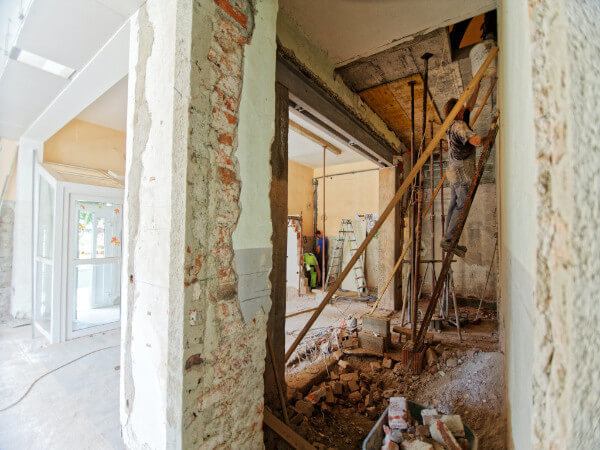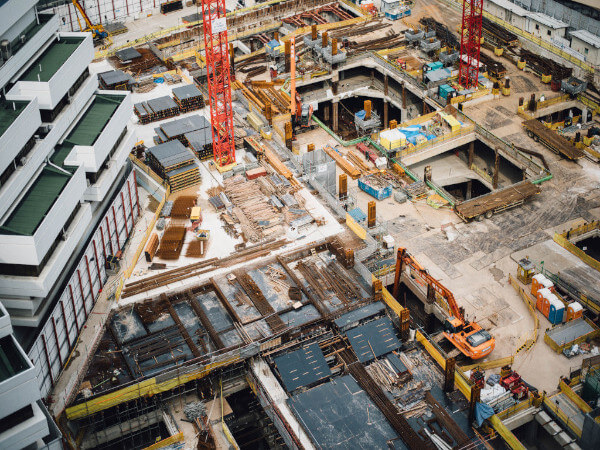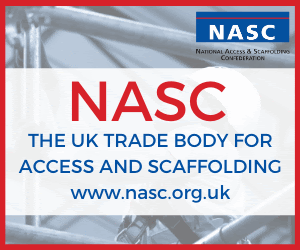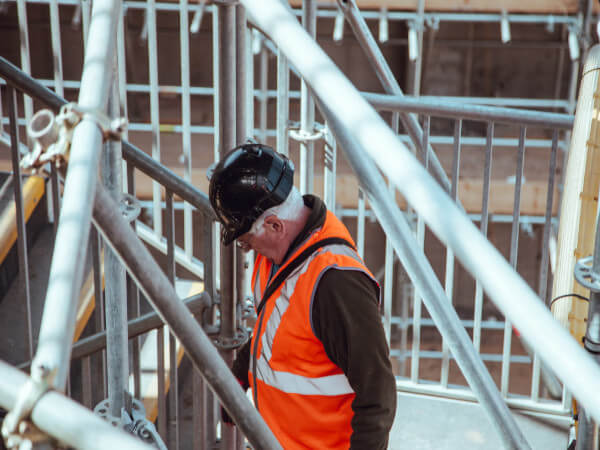Behind the Build: Interview with Daniel Charest, Project Executive, J. Calnan & Associates
One of the keys to effective technology adoption is a strong partnership with your tech provider. While the quality of technology is certainly important, you should also consider that company’s commitment to ensuring your success.
At the end of the day, successful technological deployment goes beyond savviness. It hinges on the strength of your relationships with your technology vendors and the quality of those partnerships. No one knows this better than Daniel Charest, Project Executive at J. Calnan & Associates. As someone who’s been working in the construction management realm for over 20 years, Daniel knows firsthand how essential technology partners are. Specifically, how having the right tech partner helps ensures the firm’s long-term success.
We recently caught up with Daniel and chatted about his journey to becoming a Project Executive. Check out what he has to say below.
Tell us a little bit about J.Calnan and Associates and what you specialize in.
Calnan and Associates (JC&A) is a New England-based firm that provides construction management services. We’ve been around for over two decades now, and we’re celebrating our 25th anniversary in September. We’re in the commercial construction business and our primary focus is in the corporate and the life science marketplaces. We’re fortunate to be well-seeded for a lot of new opportunities in our 25th year.
Walk us through your career. What led you to becoming Project Executive?
I graduated from Wentworth Institute of Technology in 2003 with a degree in Construction Management.
Over the course of my time there, I had co-opped at a couple of different construction companies, but predominantly at a firm that’s no longer around. And while I was there, I got to meet some really awesome individuals. I met my boss and mentor, Steve Robak, along with some others who are also here at JC&A. So, I’ve been working with Steve now for 20 plus years, and I’ve been at JC&A for nearly 17 years.
Steve and I work well together. He is Executive Vice President and Partner at JC&A and an excellent leader and guide. He’s helped me find some really awesome opportunities within the organization. Many of these opportunities challenged me as a young construction professional to set up and help add detail and focus to the then-young JC&A. One of these areas include the formation of our Technology Committee and later focus groups like our PlanGrid Build team that help train and leverage the power of technology across the organization.
I started at JC&A as an Assistant Project Manager then worked my way up to Project Manager, two to three years in. From there, I moved up to Senior Project Manager for a while. I’m now a Project Executive, and I’ve had this role for over five years with many successful projects including Bioverativ and Olympus SSA, Lifoam, Smith & Nephew and two major robotics projects in the metro Boston area; most notably Boston Dynamics new Headquarters in Waltham, MA.
As construction evolves, how do you see the role of Project Executive changing?
The way we work and function today is a little bit different than when I first got into the role. When I started as Project Executive, I was transitioning from being a senior PM and still doing a lot of that project management function. I still act in this function today, and have the ability to shift between the various ends of the PX role as the projects and client needs call for, which keeps my day interesting. I enjoy the nimbleness and the autonomy of my role, so compared to others, I might be considered more hands-on.
One of the projects that I’m gearing up for right now is our largest job ever. It’s a core shell life science building that is currently scheduled for completion in the latter half of 2023. We’re also working with some large, well-known household brands and retailers in developing their portfolio around the Metro-Boston area. All of these projects offer many new challenges for JC&A and my role as a PX to adapt our project teams to a larger project mindset for these opportunities. Everyday is truly a new day, which helps keep things interesting for sure.
A common denominator across all these projects is they are very, very demanding. So, I see the role of the Project Executive as one that’s sitting at the intersection of the client and subcontractor relationships. On any day, within minutes, I have the chance to speak with great people representing both sides of the project team. It’s a really fascinating dynamic.
And at the same time, it’s also about saying, “Hey, we’ve got this really cool project. What can we do, as we’re building it, to make ourselves better?”
That’s the mindset that I’ve been working with and continuing to build on. To succeed in this role, we shouldn’t take anything for granted, and we shouldn’t keep doing things just because that’s the way they’ve always been done. We need to strive for continuous improvement.
What project are you most proud of working on in your career? Why?
A number of projects come to mind. I often go back to our first PlanGrid project, which was the Schneider Electric Headquarters. That was a project where I was a senior Project Manager all the way through the entire duration of the project.. That said, I was often acting as a Project Executive, but I didn’t really realize that until I came out of it and looked back. It was our largest project at the time and it’s very cool to have on our resume.
“I was often acting as a Project Executive, but I didn’t really realize that until I came out of out it and looked back.” —Daniel Charest, JC&A
Since then, I’ve faced similar, yet different challenges. We had a national brand hotel project that we’ve built. Upon completing, I moved to the Project Executive role.
I’ve also had a couple of other sizable jobs, some interior fit-outs, but most notably of late was a large robotics client doing the core-shell portion for their headquarters, while another team from our company did the fit-out portion. That one is currently wrapping up over the next month or so.
Another important one is the fore mentioned Boston Dynamics headquarters. That’s my favorite job in recent history. I actually led the team that won that project! We went aggressively into the interview, and our team’s humble approach to the prospective opportunity was the client’s deciding factor in allowing us to earn the work and their trust.
What are the biggest challenges you face in your role? How does technology help you overcome those challenges?
One of the biggest challenges that we struggle with as an industry is communication. And I think the strain that COVID-19 put on our industry provided a unique opportunity for us to embrace technology and enhance our communication practices as time goes on in the JC&A organisation and industry as a whole.
That could be in the form of a Zoom call, or in our case, Microsoft Teams. We actually started implementing Teams even when nobody had a major vision for it yet. I started using many elements of Teams and the larger benefits of Microsoft 365 before COVID, with decent success, but it was difficult to see what would be needed to help change the mindset around communication protocols. Then COVID hit, and we were able to figure out pretty quickly how we could use the technology. I had people coming up to me from our IT department, and going, “Man, I’m glad you were pushing Teams out when we did because we were ready for the pandemic.” We literally discussed over the phone some quick steps to make sure all teammates could use Teams and away we went!
It was a tough period, but we’re definitely much better because of it. Aside from learning to communicate more effectively, our team became stronger working together in a different media. People learned to support one another and realized that we didn’t have to be in the same room to be there for each other. They even realized their desk line also rang their Teams line too!
When you think about the future, what are your plans to advance innovation and productivity at J. Calnan and Associates?
We’re doing a number of things with photogrammetry right now. We’re exploring it. Our feet are pretty wet in the drone world, as well. We’ve got a couple different drone types and we’ve been working with DroneDeploy. We’re really using that as the broker of the photo data, and rolling that out on some of our larger projects for cost efficiency. We’ve also done some things with HoloBuilder and Structionsite to name a few.
“It’s really exciting to have these nimble tools all in one place.” —Daniel Charest, JC&A
We’re currently using Autodesk Build on a number of projects. It’s still early days, but we’re looking forward to new features and other things in store for the software. Right now, I really like Meeting Minutes in Autodesk Build, as well as some of the insights dashboard features. It’s really exciting to have these nimble tools, all in one, place and function in a way that is easy for our team to learn these modern software.
All that being said, when it comes to technology adoption, it’s always a beta test for us. We’ll try anything. There are enough young people here in the company that we can talk to—they say, “Hey, this is the next best thing.”
We’ve had some new hires that have experienced other construction management solutions. But they look at PlanGrid and they’re like, “Wow, this is a lot better product.”
It’s clear that Autodesk is leading the way and we’re proud to work so closely with your team. I think it’s important to drive home how long we’ve been partners with the folks at PlanGrid. We started working with PlanGrid when it had fewer than 20 people, and we’ve been with the company ever since.
A colleague of mine and I both stumbled upon it when we had the iPad and we’re like, “What can we do with this? There’s got to be something we can do with this.” Going through the app store, we found PlanGrid and we said, “Let’s give this a try.”
What advice would you give to the next generation of men and women entering and preparing for the future of the industry?
Don’t be embarrassed or ever give yourself a second thought about asking a question. Whatever the question is, just ask it.
“Don’t be embarassed… Whatever the question is, just ask it.” —Daniel Charest, JC&A
You used to hear teachers say there was never a dumb question, and there really isn’t. Just question and clarify, and make sure you have a clear understanding of something. Make sure you understand what the expectation is, etc. That’s the best way to learn.
The post Behind the Build: Interview with Daniel Charest, Project Executive, J. Calnan & Associates appeared first on Digital Builder.
Digital Builder Ep 21: Bringing a Construction Data Strategy to Life

As the speed of decision-making in our industry continues to increase, data can help us not only make faster decisions, but better decisions too. Research shows that incredible opportunities exist for those who build a strong strategy for managing their data. Plus, with a well-designed data strategy, you’ll be setting yourself up to leverage more advanced technologies further down the line.
Listen to the episode now
You can also listen to this episode on Apple Podcasts, Spotify, Stitcher, Google Podcasts, and anywhere else you get your podcasts.
On this podcast episode
Jay Bowman, Managing Director of Research & Analytics at FMI, and Andy Leek, Vice President – Technology & Innovation at PARIC Corporation, join the show to discuss the many benefits of having a strong data strategy in construction.
What we discuss:
- The state of construction data today
- How to make sure you’re capturing useful data
- How a baseline of data strategy leads to more advanced technologies
- Improving data literacy in construction
- The future of data in construction
“Data strategy may seem optional today, but it’s really going to be a requirement tomorrow.” — Jay Bowman, Managing Director of Research & Analytics, FMI
Podcast highlights from Episode 21
In recent years, many perceived the construction industry as being behind the curve with technology adoption. And while there once was some truth to that, it’s clear that builders are now embracing technology at an incredible pace.
In fact, the AEC industry has done a tremendous job in closing the technology gap. JLL’s State of Construction Tech 2020 report found that in the past year, the construction industry compressed three years of technology adoption and growth into just nine months. And as Jay points out, venture capital investment “has grown ten-fold in the construction industry over the last decade.”
“I don’t know if there’s another industry where there’s really that much innovation going on. It’s actually a pretty exciting time for us,” he remarks.
In line with all this progress is a rise in the amount of data that we capture. Our research with FMI revealed that construction data has actually doubled in the last three years. So it’s not that we don’t have data—we do. We just need to make sure that we can trust the data and we’re able to put it to good use.
“What it’s coming down to now is the fact that we already have the technology,” says Andy.
“We are developing the data, and now it’s coming to a point where people need to know whether or not they can trust it. Is the cadence high enough that they can get information in a reasonable amount of time?”
This is where having a data strategy comes in.
A good data strategy enables teams to access reliable and trustworthy data so they’re empowered to work more productively, make smarter project decisions, and improve profitability. Having a data strategy in place also puts more time back into people’s lives, so they can focus on things that matter outside their primary responsibilities—both professionally and personally.
“I would like to think we get to a point where we are focused on the human side of things, in terms of helping people do a better job, to rest easier, and make sure they can go home on time and watch their kids play baseball,” remarks Andy.
“That way, they can truly have a life. People work to live, they don’t live to work.”
Four steps to building a data strategy
The conversation we had with Jay and Andy amplifies the most important takeaways from the data report we recently published, with FMI as our partner. This resource shares the findings we discovered from surveying nearly 4,000 AEC professionals on their data practices.
The report also sheds light on the actionable steps that construction firms are strongly encouraged to take when building their own data strategy.
Below is a quick summary of those steps, along with insights from Andy and Jay.
Step 1: Select a single point of focus
Companies with good data strategies have one thing in common: they all began by selecting just one area to focus on.
“In the case studies that we did, this was the common thread through everybody,” explains Jay. “No one tried to solve everything at one time, they chose one area of the organization where they could apply a solution.”
There are different ways to figure out the best point of focus. Andy recommends concentrating on places within the business where you already have measurable data.
“For us, we started in two basic areas—one was financial and the other was safety. And those were the two simplest places in our situation. We just decided to zero in on those particular areas and grow from there.”
You could also identify areas that would benefit most from data. Ask yourself, which component or department of the business would generate the most value if it had a data strategy in place?
Taking these steps narrows down the focus of your data strategy, so you can prevent being overwhelmed and get started quickly.
Step 2: Get employee buy-in to reduce hesitancy
You can’t have a data strategy without the support and commitment of other stakeholders. That’s why before rolling out your plans, ensure that you have buy-in from the right people.
According to Andy, the best way to do this is to “meet people where they’re at.”
“You’ve got to get them comfortable with the terminology. When you start throwing acronyms at people, they turn off immediately,” he adds.
When educating teams about data, make sure you’re doing it in a way that they can understand. You can do this by starting with the basics to create a foundational education.
Jay likens it to teaching someone how to drive.
“If I’m trying to teach someone to drive a car, I’m not going to tell them how an internal combustion engine works and how the metal comes together. I’m going to explain to them the gas pedal and the steering. I’m going to teach them how to use the brake.”
The same thing applies to your data strategy, he says. “We have to start at that ground level.”
You can also improve data literacy by making it easy and intuitive for teams to view and interpret data.
Over at PARIC, Andy says they did this by creating curated dashboards for their teams.
“We curated them based on their role or their phase in the project. That way, there are no endless bar graphs and pie graphs for them to try and noodle all the way through. They can easily see key insights relevant to them.”
Step 3: Standardize your data capture across all projects
The outputs or results of your data strategy will only be as good as the inputs entered into the system.
According to Jay, one of the killers of data integrity is having “multiple project inputs.”
“You would not realize that there are 30 different ways to spell the name of one supplier. Sometimes you can use all capital letters and sometimes you use just the regular capital at the beginning of the sentence… Those things, although they seem minor, actually add up and can complicate your project inputs.”
Having multiple processes is another problem, says Jay. When your data capture and QA processes aren’t uniform, you are hindering your ability to collect high-quality data and prevent your teams from gaining useful insights.
This is why standardization is so important. Before capturing and analyzing information, everyone in the organization must first agree on the formats, systems, and processes to use.
Step 4: Keep project data in a common environment
Using disconnected software and hardware isone of the top reasons for having bad data, says Jay.
In order for your strategy to be successful, you must ensure that all your data lives in one, centralized location that can be accessed by the right people. In other words, you need a common data environment (CDE).
As Jay puts it, “Standardization and creating a common data environment stood out more than anything in terms of what firms could do to address data integrity issues and limit the amount of bad data.”
If you haven’t already, decide on a single platform on which to host and analyze your data. Adopting a CDE not only ensures that teams have access to the right information, it also guarantees that they’re all working from the same data. With a CDE, project stakeholders can remain well-informed and they have the ability to collaborate more effectively.
The bottom line with data strategy
A formal data strategy gives companies a competitive advantage in today’s AEC landscape.
So, don’t wait too long to roll out a strategy in your firm. Bets are your competitors are already making progress. Start by identifying a specific area to focus on and getting buy-in from your team. From there, make sure you establish standardized data processes and adopt a CDE to keep everyone on the same page.
New podcast episode every two weeks
Digital Builder is hosted by me, Eric Thomas. New episodes of the Digital Builder podcast go live every two weeks.
If you can’t get enough of construction tech and data strategies, catch the full podcast episode of Digital Builder to hear more from Andy and Jay.
Listen to the Digital Builder Podcast on:
- Apple Podcasts
- Spotify
- Stitcher
- Google Podcasts
- or wherever you listen to podcasts
The post Digital Builder Ep 21: Bringing a Construction Data Strategy to Life appeared first on Digital Builder.
£1.7bn Blue Eden project refloats Swansea tidal energy plan
A £1.7bn project placing Wales at the forefront of renewable energy innovation has been revealed by an international consortium.
The ambitious project proposed for Swansea’s waterfront refloats stalled tidal lagoon renewable energy plans, featuring underwater turbines generating 320 megawatts from a 9.5km structure.

Blue Eden will be sited along an extensive area of land and water, south of the Prince of Wales Dock
It will also feature 1,500 waterfront homes as well as 150 floating homes in the bay, a major floating solar array and major battery storage facility.

The revived lagoon plan is part of the larger proposed Blue Eden project that’s being led by Bridgend-based DST Innovations and a number of business partners, with support from Swansea Council and Associated British Ports.
Made possible by funding from the private sector, the innovative and economy-boosting Blue Eden will be delivered in three phases over 12 years.
Blue Eden project
- A 60,000 sq m manufacturing plant to make high-tech batteries for renewable energy storage
- A battery facility to store the renewable energy produced at Blue Eden and power the site. If constructed now, it would be the world’s largest facility of its kind
- A 72,000 sq m floating solar array anchored in the Queen’s dock area
- A 94,000 sq m data centre storing, processing and providing network capabilities for the critical services
- An oceanic and climate change research centre
- Floating dome structures that will become cultural and scientific centres to be enjoyed by all
- Residential waterfront homes for 5,000 people
- Around 150 floating, highly energy-efficient eco-homes anchored in the water
All the project’s buildings and facilities, including the eco-homes, will be situated alongside the lagoon.

Renewable energy produced on site will power the entire Blue Eden development, including businesses and homes.
Due to the innovation on-site, each home will have up to 20 years’ renewable energy and heat provision included with the sale of the properties.
Tony Miles, Co-founder and Chief Executive of DST Innovations, said: “Blue Eden is an opportunity to create a template for the world to follow – utilising renewable energy and maximising new technologies and thinking to develop not only a place to live and work, but also to thrive.”

The project has been developed following discussions based on a vision put forward by a regional task force led by Swansea Council.
Cllr Rob Stewart, Swansea Council Leader, said: “Blue Eden will put Swansea and Wales at the cutting-edge of global renewable energy innovation, helping create thousands of well-paid jobs, significantly cut our carbon footprint and further raise Swansea’s profile across the world as a place to invest.

“I’m delighted that an international consortium led by a Welsh company has developed our Dragon Energy Island vision into a ground-breaking project that delivers so many benefits and builds on the council’s ambition to become a net zero city by 2050.
“This project truly is a game-changer for Swansea, its economy and renewable energy in the UK, and crucially it can be delivered without the need for government subsidies.”
Andrew Harston, Director of Wales and Short Sea Ports for ABP, said: “We are engaged in discussions around the Blue Eden project which could deliver renewable energy, new homes and skilled jobs. This innovative prototype has the potential to be a first for the UK and bring Britain closer to our net zero target.”
Subject to planning consent, Blue Eden work on site could start by early 2023.


Did you miss our previous article…
https://www.arizonasolarsociety.com/?p=1099
Cladding panels “dislodged” from McAlpine hotel job
Roads around a Hilton hotel being built by Sir Robert McAlpine in Woking were closed last week when cladding panels became “dislodged”.
Following the incident at the £540m Victoria Square development Cllr Ayesha Azad, Leader of Woking Borough Council, said on Friday: “I can confirm that following Wednesday’s incident, which saw a small number of exterior panels dislodged from the hotel development, senior officers from Woking Borough Council met with representatives of Victoria Square Woking Ltd and its contractor, Sir Robert McAlpine (SRM).
“Yesterday, a detailed inspection of the area of concern was undertaken by SRM’s sub-contractor, with further checks carried out today. As with any incident of this nature, SRM has mobilised their incident investigation team which includes independent advisers to fully scrutinise how and why this incident happened. With these investigations ongoing, it is inappropriate to speculate on the reasons why and how the panels became displaced.

“On the grounds of public safety, Sir Robert McAlpine took the decision to close Victoria Way on Wednesday afternoon in agreement with Surrey Police. Victoria Way will remain closed to traffic between the junctions with Goldsworth Road and Lockfield Drive until SRM is fully satisfied that there is no further risk to the public and construction site.
“Safety is my utmost concern and I would like to reassure members of the public that all partners involved fully understand the seriousness of the situation and are working collaboratively and expediently to resolve the matter.”


Did you miss our previous article…
https://www.arizonasolarsociety.com/?p=1094
Chancellor to detail £7bn spending pledge for local transport
Chancellor Rishi Sunak is planning to detail plans in the Autumn spending review on Wednesday to pump £7bn in local transport improvements in Midlands and Northern cities.
The pledge will amount to around £1.5bn or 20% of actual extra new cash to supplement previous spending commitments on infrastructure in the regions over the next five years.
It will be directed at areas outside of London to level up transport with new train and station upgrades and the expansion of trams, with £1.2bn also allocated to improve bus services.

Its forms part of a £26bn raft of spending commitments trialed over the weekend ahead of the Autumn spending review.
Local transport infrastructure commitments will see West Yorkshire given £830m while South Yorkshire receives £570m.
Around £1.05bn will be freshly committed in the West Midlands, £710m for the Liverpool City Region, £310m in Tees Valley and £540m to the West of England.

Rishi Sunak confirmed previously the Government had announced £4.2bn in allocation for regional transport, adding the Government would now top that up with £1.5bn while giving out the allocation for where the cash will go within the oveall local transport infrastructure cash envelope
“Greate cities need great transport and that is why we’re investing billions to improve connections in our city regions as we level up opportunities across the country.
“This transport revolution will help redress that imbalance as we modernise our local transport networks so they are fit for our great cities and those people who live and work in them,” he said in briefing mover the weekend.


Weston Homes plans £100m London flats scheme
Volume house builder Weston Homes has bought part of a former textiles dyeing factory complex in south east London for a £100m multi-storey flats scheme.
The 4.6 acre Dylon factory site will be transformed with a 254 apartments scheme with, undercroft basement parking, and children’s play space within landscaped gardens.
The site already benefits from full planning consent, granted last Spring, allowing construction to start in late 2022 with a 20 month build programme.

It forms the second phase of the redevelopment of the Dylon works following on from 223 built to Crest Nicholson undertaken in 2017.
The contemporary buildings are designed for first time buyers and will have full height windows, balconies and tiered roofscapes complete with feature London Yellow Stock brickwork, providing a connection to nearby residential buildings.

Bob Weston, Chairman and Manging Director at Weston Homes said: “This new outer London development is part of our ongoing major growth and expansion. The business has a highly diverse range of developments, including a series of major landmark schemes commencing and many others in the pipeline.”

Over the last five years, Weston Homes has purchased land sites for over £2 bn worth of residential and mixed use development across outer London and the South East.
This includes 20 current active sites and over 7,500 new homes in the pipeline including traditional housing and large scale urban regeneration projects.


Did you miss our previous article…
https://www.arizonasolarsociety.com/?p=1081
Liverpool student block developer goes under
Subcontractors and suppliers across the North West are braced to lose millions after the company behind the 16-storey Natex student accommodation scheme in Liverpool fell into administration.
Mount Group Student Natex was developing the £45m scheme which was due for completion in December.
The company is now in the hands of administrators Mazars but the wider Mount Group remains unaffected.

Mount Group Student Natex was incorporated in 2016 and work started on the 574-bed scheme in 2019 with Manchester based Barton PM as management contractor.
Mazars told the Liverpool Echo: “The administrators are presently assessing the financial position of the company with a view to determining the optimal strategy for the completion of the development.
“The company’s financial position has been adversely affected by delays and increased costs resulting from, among other factors, the Covid-19 pandemic and supply chain issues associated with the pandemic and Brexit.”

One local subcontractor told the Enquirer: “Payments have been delayed for ages on this job and suppliers are owed millions.”


Did you miss our previous article…
https://www.arizonasolarsociety.com/?p=1075
HS2 downsizes Euston station to save costs
HS2 is sliming down the planned Euston station terminus in a bid to save cost and programme time.
The station will now move to a simpler 10 platform design from the originally planned 11 platforms.
This will allow the station main contractor joint venture Mace Dragados to build the £2.6bn project in a single stage, rather than two stages as originally envisaged.
The changes are far less dramatic than some in the industry feared after a 15-month review seeking cost-saving options and efficiency opportunities, depending in part on the scope of the northern route of HS2, particularly the future of the eastern leg.

HS2 minister Andrew Stephenson revealed the new plan in a six-month update to Parliament yesterday.
He said that the changes will ease the £400m budget pressure already identified on Euston station budget.
Stephenson said the exact savings would be identified as the updated design is developed over the coming months.

“In response to a recommendation from the Oakervee Review about looking into the efficiency of the Euston station, the move to a smaller, simpler 10-platform station design at Euston has now been confirmed,” he said in the report
“This will provide a more efficient design and delivery strategy and play a significant role in mitigating the affordability pressures recently identified.
“Moving to this revised HS2 Euston station design maintains the station infrastructure capacity to run 17 trains per hour, as set out in the Phase One full business case.”
Stephenson also highlighted potential minor delays in the southern section of the line leading into Old Oak Common from outer London.
He said contractors were now focused on identifying efficiencies and controlling risk in these key areas.
The added delivery risk stems from residual delays in completing enabling works and handover to main works in certain locations.
Slower than planned design progress and securing planning consents by the main works civils contractors had also limited productivity of the supply chain.
HS2 is currently reporting future potential cost pressures of around £1.3bn compared to £0.8 billion six months ago.
The overall budget for Phase One, including Euston, remains £44.6bn. This is composed of the target cost of £40.3bn and additional government-retained contingency of £4.3bn.


Did you miss our previous article…
https://www.arizonasolarsociety.com/?p=1066
Murphy trials AI warning cameras at site danger zones
Murphy & Sons is testing the latest advances in artificial intelligence site cameras to increase worker safety on its sites.
The camera warning system monitors key exclusion zones and restricted plant and people zones on sites sounding an alarm if workers intrude on the danger zone.
This new technology can also be used to monitor for other potential health and safety issues such as incorrect PPE usage and trip hazards.
The sensors have analytical and machine learning capabilities that can send valuable metadata, which can be analysed alongside data from a range of sources, including traditional accident, incident and reporting tools, weather data to anticipate incidents and manage health and safety across multiple construction sites.

Matthew Barney, senior procurement manager at Murphy said: “This technology has the potential to play a really critical role in helping us to reduce site safety incidents and protect our colleagues.
“The ability to identify risks on site and move quickly in real time to warn of the danger is vital to helping deliver a safe environment for all our employees.

“By combining traditional health and safety methods and best practice with new technologies such as this, we will continue to deliver on our commitment to place health and safety and the very heart of our wider business.”
Known as the AiMac, the system has been developed by Murphy Technical Services and security and control systems specialist IMAC.


Did you miss our previous article…
https://www.arizonasolarsociety.com/?p=1060
£35m Nottingham art school gets green light
Plans for a £35m university building in Nottingham city centre have been given the planning go-ahead
Work will start early next year on the nine-storey block, which will house Nottingham Trent University’s School of Art and Design.
Bowmer & Kirkland and GF Tomlinson are understood to be in the bidding for the project which has been designed by architect Hawkins Brown.

The planned building at 40–42 Shakespeare Street will provide a variety of workspaces for designing and making, collaboration areas, specialist studios and labs.
The building has been designed to achieve BREEAM ‘Excellent’ and DEC ‘A’ rating.
Design decisions, such as the use of post-tensioned concrete slabs and ceramic cladding, have helped to reduce their carbon impact using Hawkins\Brown’s self-developed, open-source H\B:ERT software.
Nottingham School of Art and Design project team

Architect: Hawkins Brown
Structural & Civil Engineer: Mott Macdonald
MEP engineer: Waterman
Carbon consultant: Hawkins Brown
Project Manager: Turner & Townsend
Cost consultant: Turner & Townsend
Fire Engineer: Arup


Did you miss our previous article…
https://www.arizonasolarsociety.com/?p=1054